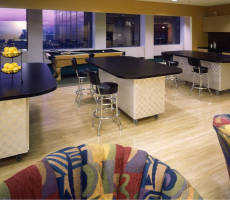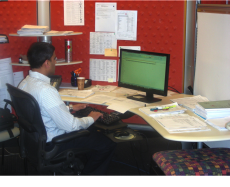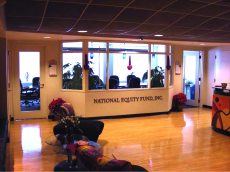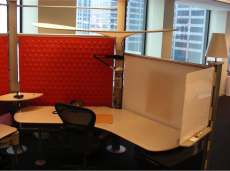April 14, 2015
The workplace as a strategic resource: a real life CEO’s perspective
 Raise your hand if you agree: “The workplace is obviously a strategic resource.” We facilities management professionals know that to be true. But if you often feel like a voice in the wilderness when speaking to anyone other than a fellow workplace professional, you are not alone. For many if not most senior executives, their facilities are a necessary evil that always cost too much. That reality frustrates me as much as it does you. So my colleague Paul Carder and I conducted two extensive research projects in 2012 and 2013 aimed at making the case (mostly to FM professionals themselves) that facilities and workplaces are incredibly strategic – and very poorly understood. And while we’ve gotten a lot of positive feedback about the work, we haven’t seen much change in mindsets, management practices or outcomes.
Raise your hand if you agree: “The workplace is obviously a strategic resource.” We facilities management professionals know that to be true. But if you often feel like a voice in the wilderness when speaking to anyone other than a fellow workplace professional, you are not alone. For many if not most senior executives, their facilities are a necessary evil that always cost too much. That reality frustrates me as much as it does you. So my colleague Paul Carder and I conducted two extensive research projects in 2012 and 2013 aimed at making the case (mostly to FM professionals themselves) that facilities and workplaces are incredibly strategic – and very poorly understood. And while we’ve gotten a lot of positive feedback about the work, we haven’t seen much change in mindsets, management practices or outcomes.
Maybe we’re just naïve optimists, but we believe deeply in the strategic impact that workplace design can have on organizational cultures and bottom-line results. I am therefore very pleased to be able to report an important story about how a workplace transformation made a major contribution to a new CEO’s ability to turn around a struggling financial services company. Picture this: On the day the company moved into a new – and dramatically redesigned – workplace, two employees bumped into each other in the hallway. One said to the other, “Who are you? Why are you walking around our office?” The other replied, “I work here – I’ve worked here for several years.” They had never seen each other before, even though the company’s headquarters office in Chicago, Illinois, is home to only about 115 employees.
 Today that company – National Equity Fund (NEF), a nonprofit financial services organization that constructs deals for the funding of affordable housing across the United States – is an industry leader that enjoys low staff turnover, high productivity, and a reputation as a high-energy, compelling place to work. It’s characterized by open collaboration and a free-flowing, can-do culture.
Today that company – National Equity Fund (NEF), a nonprofit financial services organization that constructs deals for the funding of affordable housing across the United States – is an industry leader that enjoys low staff turnover, high productivity, and a reputation as a high-energy, compelling place to work. It’s characterized by open collaboration and a free-flowing, can-do culture.
That encounter between two “strangers” took place in 2001, right after NEF moved from two floors of a dingy, cramped building to a new, open-office single-floor environment filled with Herman Miller Resolve workstations, lots of conference rooms, and an employee “Back Yard” with bright colours on the walls, a miniature golf course along the window, and a pool table where spirited games enable staff to burn off stress and enjoy each-others’ company.
And it all came about because Joe Hagan, NEF’s CEO, recognized almost immediately when he joined the company in May 2000 that the office design was completely out of sync with his values and with the culture he knew he needed to build if NEF was to survive.
He said: “The culture I found when I arrived at NEF was really depressing. People were holed up in small cubicles and hard-wall offices. The office was dark and dingy – not a place to show our customers, and not a place that our people wanted to be. They weren’t happy – I think they spent most of their time on their computers looking for other jobs.”
Ed Simon, Senior Vice President of Information Technology (IT), described his first encounter with Joe: “I was working on a new core software system for the company. I think he had been with the company about two months and he didn’t know who I was – he didn’t even know I worked there. We were all in separate offices, so no one really walked around and saw each other. We were all living in our own little silos.”
It had become clear that NEF needed a new workplace. Gaylene Domer, Vice President of Facilities, took a small team of senior executives (including Joe Hagan) to visit Herman Miller’s corporate headquarters in Zeeland, Michigan. Hagan admits today that the open nature and bright colours of Herman Miller’s Resolve® furniture at first turned him off. But Gaylene Domer persisted, arguing that a new, open office would bring staff out of the “woodwork” and help to create a collaborative work environment.
Over the next year Domer oversaw the design and build-out of a completely open and totally nonhierarchical office a few blocks  down the street. While NEF got a new open office environment where everyone, including Joe Hagan, has the same size workstation, interestingly, the design was developed rather autocratically. It was Hagan and Domer who orchestrated the new design; they only consulted with two other NEF executives as they completed the design (one was Sue Ann Reed, Senior Vice President of Human Resources, and the other was a Senior Vice President of Asset Management). Hagan did not want endless debates; he wanted results – quickly.
down the street. While NEF got a new open office environment where everyone, including Joe Hagan, has the same size workstation, interestingly, the design was developed rather autocratically. It was Hagan and Domer who orchestrated the new design; they only consulted with two other NEF executives as they completed the design (one was Sue Ann Reed, Senior Vice President of Human Resources, and the other was a Senior Vice President of Asset Management). Hagan did not want endless debates; he wanted results – quickly.
Furthermore, Hagan did not allow anyone else to see the new facility until the day the staff moved in.
Why the secrecy?
Explained Hagan: “Back in 2000 NEF ran by consensus. Everyone wanted to have a say in everything. I needed to completely change how we worked. Before the move we’d have fifteen people in the room for every decision. You can’t run a company like that.
“I had to lead; I had to define where we were going. Yes, you need to listen, but ultimately the CEO has to lead. I had to have the staff see what I wanted – so we could build on that sense of direction and move towards a more reasonable collaborative culture.”
He added: “At first I wasn’t sure about everyone having the same workstation. But then I realized that since I was accepting a smaller desk that was the same size as everyone else’s, no one could complain to me that they deserved or needed anything more than what I had.
“One reason I was willing to be tough about these decisions is that at the time I was out spending a lot of time with our investors renegotiating loans so we could retain enough cash to survive. It was ‘do or die’ for NEF. If I couldn’t pull it off, I was out the door, do I didn’t have a lot to lose by endorsing this new office design.
 “But I also knew I couldn’t make the cultural changes NEF needed without getting us out of that office. Designing the new office somewhat autocratically was a way of signaling ‘I’m in charge. This is the way we’re going to do things from now on.”
“But I also knew I couldn’t make the cultural changes NEF needed without getting us out of that office. Designing the new office somewhat autocratically was a way of signaling ‘I’m in charge. This is the way we’re going to do things from now on.”
Another part of the “new culture” at NEF was that when the staff moved into the new office Hagan wanted everything to be working right from the get-go. That was another signal that things were changing.
That vision meant the Internet access had to be up and running immediately (which in turn put significant stress on Ed Simon and his IT staff – but late at night after a very long three-day weekend right before the actual move-in they got everything hooked up and working).
On the Tuesday after Labor Day 2001 the staff moved in to the new facility. But no one received a floorplan or any directions to their new workstation. Instead, Hagan wanted them to wander around the office in search of their new “home” (and thus be exposed to the entire office). That led to lots of people walking all over the new space, bumping into each other, and meeting some of their colleagues for the first time.
In addition, Hagan insisted that everyone get rid of their boxes from the move within two days. He wanted the place to look (and to be) settled. That was part of the strategy of having a company home that would impress investors, customers, and prospective customers. And it was also about being focused on getting back to business, not wasting time, and being professional.
Joe Hagan had come to NEF from a banking background, and he knew how important appearances are in the financial services industry. As others have often pointed out, success in the financial services industry often depends on creating a self-fulfilling prophecy. A big part of becoming successful is looking successful – even before that’s completely true.
In hindsight the 2001 move to a completely new corporate headquarters – characterized by an open office plan, lots of meeting space, a fancy waterfall sculpture in the main lobby, and an employee lounge area with soft seating, a pool table, and a miniature golf course – was a clear strategic success. However, back in 2001 the move had felt like a major risk. But as Joe Hagan reflected on the decision, he saw it as part of an “all or nothing” effort to transform the company’s culture and its bottom line.
And it worked. In his words: “It was completely transformational. I was standing in the lobby greeting people as they came in for the first time. And I could see how impressed and excited they were as they walked around the building. And within a couple of weeks they were bringing their families in to the see the new space. That’s when I knew we were succeeding. They weren’t job hunting anymore. They felt good about the space, and that made them feel good about the company.”
Now fast-forward to 2014. NEF is getting ready to move once again. Why? The office still looks very much like it did in 2001, and the staff still likes working there. The company continues to be an industry leader; it’s not in need of a dramatic turnaround.
But – and this is both obvious and critical – much has changed over the last decade. The last five years have been a very tough time in the financial services sector. The “Great Depression” and the housing debacle have put incredible economic pressure on NEF and its competitors (to say nothing of publicly funded housing).
Just as importantly, technology has totally changed the way the company does business and the way its employees communicate with each other and with customers and investors. The current facility was designed before WiFi was common; while there is a wireless network in the building now, it is not particularly robust – there are several known “dead zones” throughout NEF’s office.
In addition, with the growth of cloud computing services there isn’t the same need for on-site servers and data storage capacity. And since almost everyone has a smart mobile phone and laptop computer today, there isn’t the same need for all the staff to be in the office all the time.
These new conditions led NEF in 2012 to begin exploring a range of new possibilities for supporting and provisioning its headquarters staff. The first step in what has become known as “Project CHANGE” was to develop a part-time work-from-home program for some employees. The company conducted a careful analysis of which jobs could be handled at least part-time from employees’ homes, what the current commuting patterns were, and what impact a more distributed work pattern would have on core business processes as well as employee attraction, retention, and productivity.
To guide that analysis, and to help orchestrate the cultural and management changes central to implementing a work from home program NEF engaged The Future of Work…unlimited and its executive director (the author of this article). Gaylene Domer, Sue Ann Reed (SVP of HR), and Ed Simon (Chief Information Officer), with support from the author, spent about a year collecting data and developing a business case for enabling a whole new way of working at NEF – one that leveraged new IT capabilities and recognized the way the NEF workforce was already beginning to embrace flexible work.
Our analysis suggested that if about one third of the staff worked from home two to three days a week the company could reduce its office footprint by about 25% – while at the same time upgrading from Class B to Class A real estate and adding a significant number of new conference rooms of varied sizes.
During one executive committee conversation about the proposed move to a smaller but better facility, in combination with an aggressive workforce mobility initiative, Joe Hagan commented “What do we care where someone is when they get their work done? If they meet their goals on time and on budget it really doesn’t matter where they are when they do it.”
That is clearly not yet a common view among senior business executives; but it reflects Joe Hagan’s basic commitment to turning staff loose to make their own decisions about where, when, and how they complete their work – all the while holding them accountable for the results they produce (or do not produce).
The bottom line is that now, in 2014, approximately 40 NEF employees are spending 2-3 days working from home (and the company will be moving to a new, smaller but better facility at the end of August). Employee satisfaction with the new work arrangement is high, the managers of mobile workers are uniformly supportive of the new work environment, and the company expects to save at least $2 million dollars a year in real estate costs.
This piece is taken from the next issue of Work&Place, which will be published tomorrow.
_______________________________________________
 James Ware, PhD is a Global Research Director for Occupiers Journal Ltd. He is also the founder and Executive Director of The Future of Work…unlimited, and a Partner with The FutureWork Forum. Jim was a co-author and the lead editor for Cut It Out! Save for Today, Build for Tomorrow, published by the IFMA Foundation in 2009. He also authored the chapter on change management for the recently-completed book Work on the Move: Driving Strategy and Change in Workplaces, also from the IFMA Foundation (October 2011). He holds a PhD, M.A., and B.Sc. degrees from Cornell University and an MBA (With Distinction) from the Harvard Business School.
James Ware, PhD is a Global Research Director for Occupiers Journal Ltd. He is also the founder and Executive Director of The Future of Work…unlimited, and a Partner with The FutureWork Forum. Jim was a co-author and the lead editor for Cut It Out! Save for Today, Build for Tomorrow, published by the IFMA Foundation in 2009. He also authored the chapter on change management for the recently-completed book Work on the Move: Driving Strategy and Change in Workplaces, also from the IFMA Foundation (October 2011). He holds a PhD, M.A., and B.Sc. degrees from Cornell University and an MBA (With Distinction) from the Harvard Business School.













